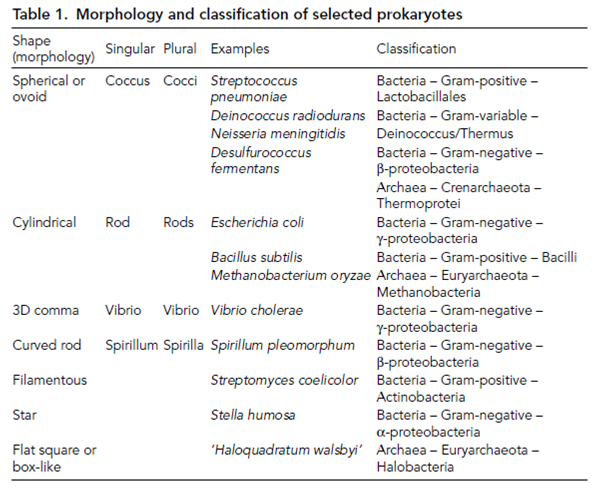Morphological diversity
The model organism used in bacteriology and Escherichia coli is a rod-shaped organism about 3 mm in length and 1 mm in diameter. Various very different Bacteria have this rod- like morphology sometimes called a bacillus. The Bacilli can be established in all the taxonomic groups of the Bacteria as well as in the Archaea. This means that unlike the classification of higher organisms shape is not a reliable characteristic when classifying prokaryotes even though it is one of the few visible differences among cells when using a light microscope. Through, the shape of some microorganisms has had an influence on the naming of some prokaryotes. The Gram-positive Bacteria genus Bacillus is of course, made up of rod-shaped species, through another Gram-positive genus, Streptococcus, is made up of species of spherical bacteria about 1 mm in diameter.
Archaea and Bacteria are considered to be independent single-celled microorganisms dividing through a procedure of binary fission and so both mother and daughter cells are the similar size after division. Most bacteria are of regular shape, simple but a few exceptions, like the star-shaped bacterium Stella humosa exist. Some bacteria like as the Actinomycete Streptomyces coelicolor grow as multi- nucleate filaments in that the concept of a discrete cell becomes more esoteric.
Several prokaryotes form smaller cells when stressed and these are by to be resting stages. The smallest vegetative prokaryotes are the marine ultramicro bacteria such as Sphingopyxis alaskensis whose diameter is less than 0.3 mm and has an estimated cellular volume of less than 1 mm3. The chlamydia and mycoplasmas are the smallest bacteria recognized colonizing humans Mycoplasma genitalium is only 0.2 through 0.3 mm. Although these

seem tiny compared with eukaryotic cells 2–200 mm the theoretical size limit of life was calculated through the US National Academy of Sciences Space Study Board to be a spherical cell of 0.17 mm. This minimum size supposes the presence of a minimum genomic complement plus the ribosomes and other subcellular parts needed for existence. While nanobacteria of about this size have been observed in nature it is now thought which these are produced through crystallization, despite the presence of membranes bounding the particles.
The largest known prokaryote is the sulfur bacterium Thiomargarita namibiensis that is 750 mm in length and has a diameter among 100 and 250 mm. Close relatives of this bacterium can form filaments various centimeters long. These and Bacteria like as Epulopiscium fishelsoni can just be seen with the naked eye. Under the light microscope, organisms such as Bacillus megaterium and the cyanobacterium Oscillatoria seem unusually large. These large bacteria have little more cytoplasm than a single E. coli, and most of the cellular volume is made up of vacuoles since diffusion is the major method of movement of all prokaryotic metabolites and substrates. All the cytoplasm of a large cell must be close to a cellular membrane so the vacuole structure allows the organism to grow to larger sizes.